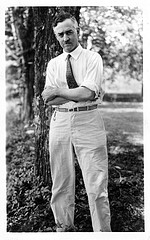
Not so long ago, while helping to draft a piece for NCSE’s regular column in Evolution: Education and Outreach, I found myself wanting to invoke a familiar threefold distinction between evolution as fact, evolution as theory, and evolution as path. A modern locus classicus is T. Ryan Gregory’s “Evolution as Fact, Theory, and Path” (PDF) which appeared in the inaugural issue of Evolution: Education and Outreach, so I duly cited it along with Stephen Jay Gould’s “Evolution as Fact and Theory,” which appeared in Discover in 1981. Gregory also cites Michael Ruse’s book Taking Darwin Seriously (1997), which I was going to cite as well, but when I looked at it, I noticed that it began, “In dealing with evolution, I make a three-part division (Ruse, 1984b),” which impelled me to cite Ruse’s 1984 article, published in BioScience, in preference to the book.
That was about as far as I was prepared to pursue the threefold distinction at the time, but I recently stumbled across a nice statement of it by Winterton Curtis (seen above). Curtis, as habitués of the Science League of America will recall, was a professor of zoology at the University of Missouri, and was one of the expert witnesses asked to testify for the defense in the Scopes trial of 1925. In his contribution to D-Days at Dayton (1965), he speculates about why he was asked: “probably due to my activities in defense of evolution as well as to my geographical location, to my recent book Science and Human Affairs [1922], and to whatever standing I had as a zoologist.” He adds, self-deprecatingly, that “several of the then elder statesmen of zoology” declined to participate, regarding it as “beneath the dignity of a zoologist of national reputation”—and giving him a chance!
Anyhow, Curtis was prepared to testify for the defense. But Judge Raulston, presiding over the trial, decided that the defense expert witnesses would not be allowed to testify. In his history of the trial Summer for the Gods (1997), Edward J. Larson writes, “He clearly wanted to hear the experts but felt pressure from state leaders who, fearing that such testimony would heap further ridicule on Tennessee and its law, pointedly had declared that the trial should be brief.” For the purpose of creating a record for appellate review, however, the defense experts were allowed to submit written affidavits or read prepared statements into the record. Curtis’s statement—which in 1965 he described as “what might have been expected in any authoritative textbook of general zoology in use by the better colleges and universities at that time”—included the following.
Suppose we begin with an analogy, illustrating what may be termed the fact, the course and the causes in a progressive series of events. A ship leaves a European port for the New York harbor. We may distinguish between: (1) The fact that the ship actually crossed the ocean, instead of being “created” in the harbor of New York; (2) the course the ship may have pursued, whether direct or indirect, and the like; and (3) the causes that made the ship go, whether an internal propelling force like steam or electricity, an external force like wind or current or even direction by wireless. Compared with the doctrine of evolution, we have: (1) the fact of evolution, as representing the historical series of events; (2) the course followed in evolution, for instance, whether the land vertebrates arose from the fishlike ancestors, birds from reptiles, or the like; and (3) the cause of evolution or what made and makes it happen. These three aspects, like those in the voyage of a ship, are separate though related items. They must be constantly distinguished if there is to be any clear thinking on this matter by one who is not a scientist.
Curtis wasn’t, as it happens, introducing the threefold distinction in his testimony for its own sake, but rather in the service of explaining that William Bateson, in his notorious 1921 talk on “Evolutionary Faith and Modern Doubts,” often exploited by creationists of the day, was expressing agnosticism not about the fact of evolution but about its causes. But he added, “With this distinction between fact, course and causes clearly in mind, the significance of Darwin’s work in the history of biological thought can be understood.” Darwin presented abundant evidence for evolution as a fact, Curtis explained, and moreover provided “a then plausible theory of evolutionary causation” in the form of natural selection. Curtis’s testimony is cautious about natural selection—“more cautious than I would write today,” he observed in his D-Days at Dayton piece forty years later.
Clearly Curtis’s distinctions between fact, course, and causes are more or less the same as Gregory’s distinctions between fact, path, and theory. (Only more or less, I think, since a captious reader might hold, for example, that evolutionary theory is not exhausted by a listing of relevant causes.) And the analogy that Curtis offers is quite remarkably helpful, in giving a vivid and everyday example in which the same distinction obviously applies. (Well, everyday as of the 1920s, when trans-Atlantic shipping presumably figured larger in the popular imagination than today.) It’s so helpful, however, that it’s hard to believe that it was original with Curtis (who seems not to claim any originality with regard to it). But there are so many ways of expressing the point that it’s hard to research who might have arrived at it first. Any ideas from the peanut gallery?

